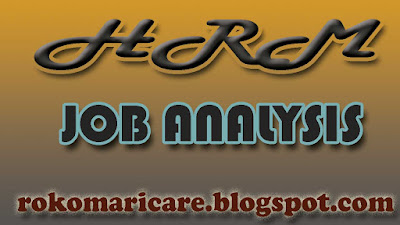HRM | Job analysis , Job Description ,Job Evaluation ,Job Specification
Job analysis | Job Description
| Job Evaluation | Job Specification
 |
Job analysis, Job Description, Job Evaluation, Job
Specification
|
Definition of job Analysis: Job analysis is a technical procedure used
to define a job duties , responsibilities, and accountabilities. This analysis
involves the identification and description of what is happening on the job,
accurately and precisely identifying the required tasks, the knowledge and the
skills necessary for performing them, and the conditions under which they must
be performed.
Or
It is the process used to collect information
duties, responsibilities, necessary skill outcomes and work environment of a
particular job.
Job Analysis Methods.
# Observation Methods
#
Individual Interview Methods
# Group Interview Methods
# Structured Questionnaire Methods
# Technical Conference Methods
# dairy Methods.
Explanation
of Job Analysis Methods.
Observation Methods:-
A job analysis technique in which data
are gathered by watching employees work. This method requires that the entire
range of activities be observable; possible with some jobs, but impossible for
many.
Individual Interview Method:-
Under this method, a team of incumbents assembles for extensive individual
interviews. The results of these interviews are combined into a single job
analysis. This method is very time consuming but effective.
Group Interview Method:-
This method is similar to the individual interview method except that a number
of job incumbents are interviewed simultaneously. Accuracy is increased in
assessing jobs, but group dynamics may hinder its effectiveness.
Structured Questionnaire Method:-
This method gives workers a specifically designed questionnaires on which they
check on rate items they perform in their job from a long list of possible task
items. This technique is excellent for gathering information about jobs.
Technical Conference Method:-
This method uses supervisions with extensive knowledge of the job. Here,
specific job characteristics are obtained from the experts. Although a good
data gathering method, it offers overlooks the incumbent worker. Perceptions
about what they do on their job.
Dairy Method:-
This method requires job incumbents to record their daily activities. This is
the most time consuming of the job analysis methods because to capture the
entire range of work activities, this method may have to continue long period
of time- all adding to its cost.
Purpose of
job analysis :
Job Analysis
Process generates 3 tangible outcomes:
# Job Description
# Job
Evaluation
# Job Specification
Job
Description:
A
job description is a written statement of What the jobholders does, how it is
done, under What conditions, and why. Job description also details the skills
and qualifications that on individual applying for the job needs to process. A
common format for a job description includes the job title, the duties to be
performed. Qualifications in terms of education and work experience to be
required, skills nets required to fulfill the job, salary range.
There is no standard format
for writing a job description. However, most descriptions contain sections that
cover:
1. Job identification
2. Job summary
3. Responsibilities and duties
4. Authority of incumbent
5. Standards of performance
6. Working conditions
7. Job specifications
1. Job identification
2. Job summary
3. Responsibilities and duties
4. Authority of incumbent
5. Standards of performance
6. Working conditions
7. Job specifications
job
description Writing system
Writing Job Descriptions
Sections
of a Typical Job Description= Job identification→ Job summary→ Responsibilities and duties→ Authority of the incumbent → Standards of
performance →Working conditions →Job specifications
The
Job Description
• Job
Identification
– Job
title
– Preparation
date
– Prepare
• Job
Summary
– General
nature of the job
– Major
functions/activities
• Relationships
– Reports
to:
– Supervises:
– Works
with:
– Outside
the company:
• Responsibilities
and Duties
– Major
responsibilities and duties (essential functions)
– Decision-making
authority
– Direct
supervision
– Budgetary
limitations
• Standards
of Performance and Working Conditions
– What
it takes to do the job successfully
Job
Specification:
Definition of Job Specification:
The job specification states the minimum
acceptable qualifications that’s the incumbents must possess to perform the job
successfully. Based on information acquired through job analysis, the job
specification identifies pertinent knowledge, skills, education, experience,
certification and abilities. The job specification, therefore, is an important
tool for keeping the selection’s attention on the list of necessary
qualifications and assisting in determining whether candidates are essentially
qualified.
Job specification comprises----
Statement of individual
Qualification necessary to do job
Education
Experience
Training
Initiative
Physical abilities
Psychological abilities
Communication skills
Responsibilities
Sensory demands
# Job
Specification: = Qualification,
Qualities, Experience, Family Background, Training, Interpersonal skill.
Job
Evaluation:
Definition of Job Evaluation:
Job analysis also provides valuable
information for making job comparisons. If an organization is to have and
equitable compensation program, jobs that have similar demands in terms of skills, knowledge and abilities should be
placed in common compensation groups. Job evaluation contributes by specifying the relative
value of each job in the organization,
which makes it an important part of compensation administration.
# Job evaluation is a systematic and orderly
process of determining the worth of a job in relating to other job.










No comments